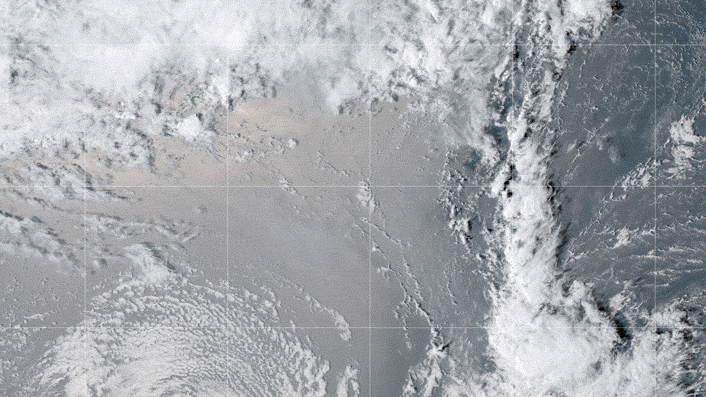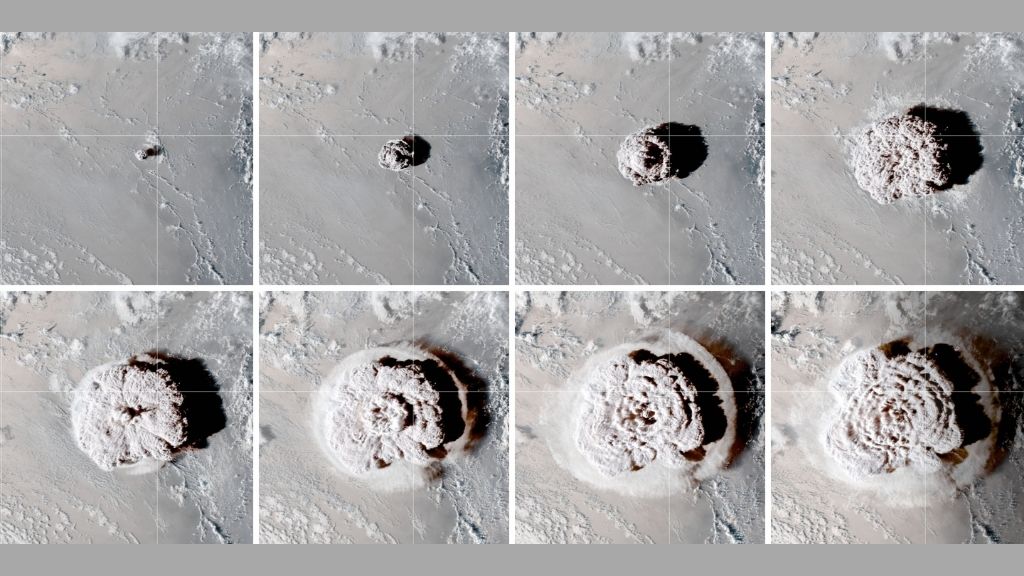Record-shattering Tonga volcanic eruption sent atmospheric waves zipping around the Earth
The eruption also caused fast-moving tsunamis.

An underwater volcano erupted in January near the Pacific nation of Tonga and sent massive pressure waves racing through Earth's atmosphere, where they lapped the planet several times. The last volcano to generate such large ripples in the atmosphere was Krakatau in 1883, during one of the most destructive volcanic eruptions in recorded history, a new study shows.
"This atmospheric wave event was unprecedented in the modern geophysical record," said first author Robin Matoza, an associate professor in the Department of Earth Science at the University of California, Santa Barbara. The research, published Thursday (May 12) in the journal Science, revealed that the pressure pulse generated by the Tonga volcano was "comparable in amplitude to that of the 1883 Krakatau eruption and over an order of magnitude greater than that of the 1980 Mount St. Helens eruption," Matoza told Live Science in an email. The higher the amplitude of a wave, the more powerful it is.
A second study, also published May 12 in Science, suggested that this powerful pulse not only jiggled the atmosphere, but it also sent ripples racing across the ocean below. In fact, the atmospheric waves generated small, fast-traveling meteotsunamis — meaning series of waves driven by air-pressure disturbances — which reached the shore hours before the conventional, seismically-driven tsunamis generated by the volcano's blast.
These small "forerunner" tsunamis were observed all around the world, primarily in the Pacific Ocean, but also in the Atlantic Ocean and Mediterranean Sea, surprisingly, said Tatsuya Kubota, a research fellow at the National Research Institute for Earth Science and Disaster Resilience in Japan and first author of the second study. "The height of the 'forerunner' tsunamis … was approximately a few centimeters or so, although it depends on the location," Kubota told Live Science in an email.
Related: Dramatic photos show horrific aftermath of massive Tonga eruption and tsunami
An extremely energetic eruption
The Tonga volcano — called Hunga Tonga-Hunga Ha'apai, or just Hunga — lies about 40 miles (65 kilometers) northwest of the Tongan capital of Nuku'alofa. It's one of 12 known underwater volcanoes in the Tonga-Kermadec volcanic arc, a geological structure that runs along the western edge of the Pacific plate of the Earth's crust, according to the Smithsonian's Global Volcanism Program.
When Hunga erupted in mid-January, the resulting plume of gas and particles hit the mesosphere — the third layer of the atmosphere above Earth's surface — making it the largest volcanic plume in the satellite record. The amount of energy released in the eruption was comparable to what might be generated by 4 to 18 megatons of TNT exploding, or more than 100 Hiroshima-scale bombs detonating at once.
Sign up for the Live Science daily newsletter now
Get the world’s most fascinating discoveries delivered straight to your inbox.
Following the record-shattering eruption, Matoza and a team of more than 70 scientists from 17 nations set out to document what atmospheric waves were generated by the blast. To do so, they pulled data from numerous ground-based and spaceborne monitoring systems that had recorded the eruption as it unfolded.
The team found that, of all the atmospheric waves produced by the blast, so-called Lamb waves stood out as most prominent. Lamb waves run along the surface of the Earth and are similar to sound waves in that they produce vibrations in the medium they're traveling through. However, Lamb waves propagate at extremely low frequencies, "where the effects of gravity become significant," Matoza said.

Researchers rarely record Lamb waves, because they only arise from enormous explosions in the atmosphere, on the scale of large volcanic eruptions and nuclear tests. "They are not usually observed for smaller volcanic eruptions," Matoza told Live Science.
Related: 4-foot tsunami hits Tonga after explosive eruption of underwater volcano
At their tallest, the Lamb waves generated by the Hunga eruption had an amplitude of 280 miles (450 km), meaning they hit the ionosphere — a dense layer of electrically charged particles that lies about 35 to 620 miles (60 to 1,000 km) above the planet's surface. Over the course of six days, these waves radiated outwards from the volcano site, circling the Earth four times in one direction and three times in the other. Based on historical data, the 1883 Krakatau eruption generated Lamb waves that circled the Earth the same number of times, the researchers reported.
The team's Lamb wave observations align with earlier models of the Hunga eruption event that were produced by Nedjeljka Žagar, a professor of theoretical meteorology at University of Hamburg, and her colleagues. "We were able to simulate the Hunga Tonga Lamb wave just two days after the event," and now, the new Science study has provided more detail as to how these waves propagated, using various geophysical measurements, Žagar told Live Science in an email.
In their own Science study, Kubota and his colleagues connected the dots between these Lamb waves and the speediest tsunamis observed after the eruption. The timing of the Lamb waves and "forerunner" tsunamis seemed to coincide, they found. What's striking is that these forerunner waves landed ashore more than two hours earlier than would be expected for conventional tsunamis, which are largely driven by sudden deformations in the seafloor.
In addition to huge Lamb waves and fast-moving tsunamis, the Hunga eruption also produced incredibly long-range sound waves and infrasound waves — meaning acoustic waves too low in frequency to be heard by humans, Matoza and his colleagues reported. The prominent Lamb waves led the pack, followed by the infrasound waves and then the audible sound waves. Remarkably, audible sounds, consisting of short, repeated "booms," were reported all across Alaska, more than 6,200 miles (10,000 km) from the Hunga eruption.
Originally published on Live Science.

Nicoletta Lanese is the health channel editor at Live Science and was previously a news editor and staff writer at the site. She holds a graduate certificate in science communication from UC Santa Cruz and degrees in neuroscience and dance from the University of Florida. Her work has appeared in The Scientist, Science News, the Mercury News, Mongabay and Stanford Medicine Magazine, among other outlets. Based in NYC, she also remains heavily involved in dance and performs in local choreographers' work.










